#battle of the teutoburg forest
Text

Hermann's triumph after his victory over Varus by Johann Heinrich Tischbein
#arminius#hermann#varus#teutoburg#battle of the teutoburg forest#varian disaster#germania#art#johann heinrich tischbein#germanic#roman#romans#roman empire#history#teutoburg forest#antiquity#triumph#europe#european#germany#german#publius quinctilius varus#legions#legion#ancient rome#eagle#eagles#standard#armour#spolia opima
39 notes
·
View notes
Video
youtube
Legio Aeterna Victrix but you're marching through Teutoburg Forest and can't find Arminius

#battle of the Teutoburg forest#9AD#Publius Quinctilius Varus#Arminius#Germania#wojack#a bad time#Quintilius Varus give me back my legions!#Roman empire#history
10 notes
·
View notes
Text
I gotta talk about this cause mmmmm
but the battle of the teutoburg forest is a HUGE reoccurring interest of mine! Every year I go either to the Varus Schlacht Museum or the Hermann Denkmal and I live so close to the place of the actual happenings, I even have a jacket with the face of the Hermann Denkmal on it and I just get so hyped everytime I see people talk about Barbaren/Barbarians because yes that's my blorbo topic
#rambling moss#I'm not allowed to wear the jacket anymore tho#it's literally falling apart#text#Varusschlacht#Hermann#Varus Schlacht#Battle of the teutoburg forest#barbaren#barbarians#history#historical interest
6 notes
·
View notes
Photo

Otto Albert Koch: Varus Battle, 1909
The Battle of the Teutoburg Forest, described as the Varian Disaster (Clades Variana) by Roman historians, took place at modern Kalkriese in AD 9, when an alliance of Germanic peoples ambushed Roman legions and their auxiliaries, led by Publius Quinctilius Varus. The alliance was led by Arminius, a Germanic officer of Varus's auxilia. Arminius had acquired Roman citizenship and had received a Roman military education, which enabled him to deceive the Roman commander methodically and anticipate the Roman army's tactical responses.
Teutoburg Forest is commonly seen as one of the most important defeats in Roman history, bringing the triumphant period of expansion under Augustus to an abrupt end. The outcome of this battle dissuaded the Romans from their ambition of conquering Germania, and is thus considered one of the most important events in European history. The provinces of Germania Superior and Germania Inferior, sometimes collectively referred to as Roman Germania, were subsequently established in northeast Roman Gaul, while territories beyond the Rhine remained independent of Roman control. Retaliatory campaigns were commanded by Tiberius and Germanicus and would enjoy success, but the Rhine would eventually become the border between the Roman Empire and the rest of Germania. The Roman Empire would launch no other major incursion into Germania until Marcus Aurelius (r. 161–180) during the Marcomannic Wars.
Some of the descendants of the vassal kingdoms, like the Suebi (by suzerainty), that Augustus tried to create in Germania to expand the romanitas and the Empire in a peaceful way would be the ones that invaded the Empire in the fourth and fifth centuries.
#Battle of the Teutoburg Forest#Varian Disaster#Arminius#Publius Quinctilius Varus#AD 9#roman empire#german history#ancient roman history#Otto Albert Koch#paintings#art#arte#XX century
2 notes
·
View notes
Photo

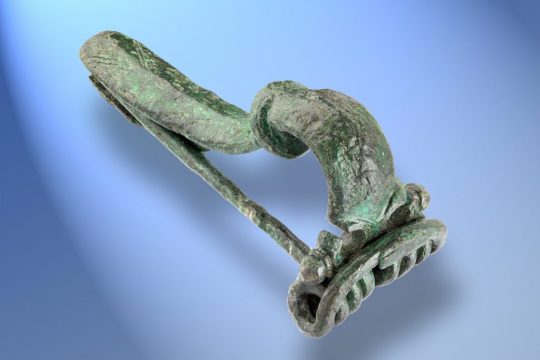




The Roman 19th Legion Identified at Teutoburg Battle Site that shook Rome in AD9
Researchers in Germany have identified the metallurgic signature of the Roman 19th Legion in artifacts recovered from the Battle of Teutoburg Forest in Kalkriese, Germany, using a new chemical analysis method.
The Roman defeat by Germanic tribes at the Battle of Teutoburg Forest in AD9 was such a disaster that it sent shockwaves throughout the empire. Three legions, totaling up to 20,000 men, were lost.
Now scientists used chemical analysis methods to track down the destroyed legions in Kalkriese and were able to identify the 19th Legion in Kalkriese.
The characteristic composition of trace elements in an artifact can be identified by mass spectrometer analysis of non-ferrous metals like bronze and brass. Because each Roman legion had its own blacksmiths who worked constantly on the campaign to repair and replace weapons and equipment, even legions that fought together had a distinct chemical signature in their metals.
When dating and identifying complex battlefield remains like those at Kalkriese, the fact that this method can be used to conclusively link an object to a specific legion is a major archaeological breakthrough.
The discovery of coins and slingshot ammunition in a field in northeastern Germany in 1987 by Tony Clunn, a British army officer and amateur archaeologist, fueled speculation that the battle site had been discovered. However, for decades it was only a plausible theory.
Since then, Kalkriese has unearthed more than 7,000 artifacts, ranging from complete horse bridle fittings to everyday items to the oldest set of Roman plate armor ever discovered in Germany. Undoubtedly, a significant Roman battle from the first century took place there, but it took decades for the Teutoburg battlefield to be identified, and there is still some scholarly disagreement on the matter. For instance, it might have been a battle that happened during Germanicus’ campaign six years later. The archaeological finds cannot be dated within a six-year range by any scientific dating method available to us.
Let’s introduce the metallurgic signature. 550 samples were taken for the project from non-ferrous metal artifacts found at Kalkriese.
The metals used for repairs in the camp forges contain trace elements in such small amounts that the Roman forges did not notice them, and they were not intentionally manipulated. These elements entered the metals through the original ores, various additives used during processing, and tool adhesions. On-site processing has caused the legions to develop a distinct pattern in the composition of trace elements over time.
“In this way, we can allocate a legion-specific metallurgical fingerprint to the legions, for which we know the camp locations at which they were stationed,” German Mining Museum Bochum researcher Annika Diekmann continues. Based on this, all Roman non-ferrous metals from Kalkriese were sampled and compared with non-ferrous metals from numerous Roman locations where it is known from written records which legions were stationed here.
After the analysis is complete, it is evident that the 19th Legion in particular, which perished with Varus and was stationed in Dangstetten in southern Germany years earlier, stands out from the other legions, which were only deployed later in Germany in the Roman vengeance campaigns. This is based on the composition of the trace elements.
“When comparing the finds from Kalkriese with the finds from the other sites, we find that the finds from Dangstetten and Kalkriese show significant similarities. The finds that come from legion sites whose legions did not perish in the Varus Battle, on the other hand, differ significantly from the finds from Kalkriese and thus show significant differences to the finds from Kalkriese.
#The Roman 19th Legion Identified at Teutoburg Battle Site that shook Rome in AD9#The Battle of the Teutoburg Forest#Varian Disaster#Arminius#Augustus#archeology#archeolgst#ancient artifacts#history#history news#ancient history#ancient culture#ancient civilizations#roman history#roman legion#roman 19th legion
50 notes
·
View notes
Text
While men are busy thinking about the Fall of the Roman Empire, I'm still thinking about my lost legions.
Quintili Vare, legiones redde!!!!!!
#The Battle of the Teutoburg Forest#Roman memes#Rome#Augustus Caesar#dark academia#gothic academia#darkest academia#chaotic academia#academia#vampire academia#light academia#goth#gothic#victorian gothic
9 notes
·
View notes
Text
I got the ultimate best compliment at work today: I was told I look good with a weapon in hand and that I look like a true barbarian woman.
#never felt so flattered#hahahakahahaha#me in my doc martens in a german forest spear in hand explaing kids the battle of teutoburg forest#the kids agreed😭😭😭#lesbians should be allowed weapons because we look hot with ut#personal
4 notes
·
View notes
Text
My friend (@helldava): You may leave the Teutoburg forest, but the Teutoburg forest does not leave you.
Me: You don't come out of the Teutoburg forest, my friend.
#not incorrect quotes#my quotes#spqr#rome#imperio romano#imperium#roman empire#augustus#teutoburg#teutoburg forest#roman#arminius#gaius julius arminius#latin#roma#history#barbarians#battle of teutoburg#germans#roman soldiers
10 notes
·
View notes
Link
After centuries shrouded in mystery, the actual site of the decisive Battle of Teutoburg Forest has finally been uncovered. This pivotal clash in 9AD saw Germanic tribes led by Arminius destroy three Roman legions, altering the course of history. While long assumed to have occured by the Hermann Monument, archaeological work in Kalkrich in 1988 uncovered decisive evidence that pointed to this remote village as the true location. Coins and artifacts prove this was the site of the three-day engagement, contradicting previous myths. Visitors can now walk the true grounds where the Germanic revolution against Rome was ignited.
0 notes
Text

Battle Scene with Varus falling on his sword during the Battle of the Teutoburg Forest
by Martin Disteli
#battle of the teutoburg forest#varus#publius quinctilius varus#ancient rome#germania#roman empire#roman#romans#antiquity#eagle#art#martin disteli#germanic#tacitus#history#arminius#europe#european#teutoburg#teutoburg forest#battle#rome#legion#legions#soldiers#soldier#warrior#warriors#standard#standards
33 notes
·
View notes
Video
youtube
The Grim Truth Behind The Massacre of 20,000 Roman Soldiers | Lost Legio...
0 notes
Text
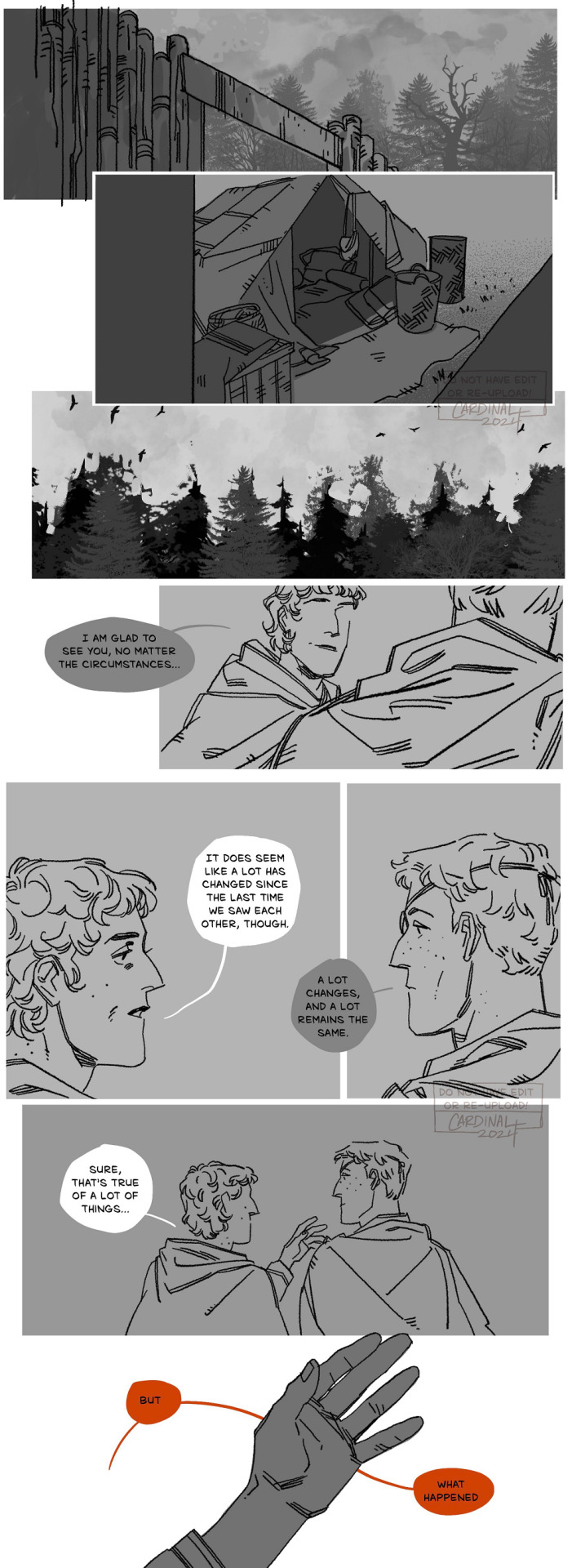
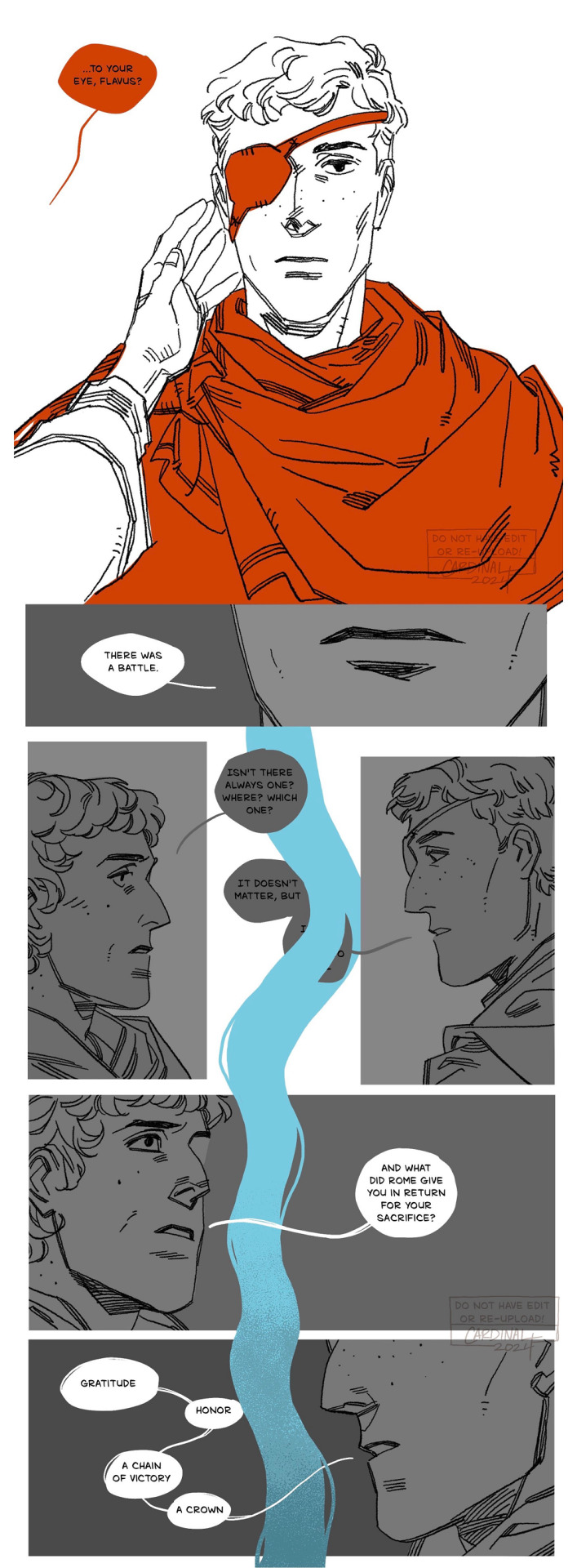


BROTHERS
The river Weser ran between the Roman and Cheruscan forces. Arminius came to the bank and halted with his fellow chieftains:— "Had the Caesar come?" he inquired. On receiving the reply that he was in presence, he asked to be allowed to speak with his brother. That brother, Flavus by name, was serving in the army, a conspicuous figure both from his loyalty and from the loss of an eye through a wound received some few years before during Tiberius' term of command. Leave was granted, and Stertinius took him down to the river. Walking forward, he was greeted by Arminius; who, dismissing his own escort, demanded that the archers posted along our side of the stream should be also withdrawn. When these had retired, he asked his brother, whence the disfigurement of his face? On being told the place and battle, he inquired what reward he had received. Flavus mentioned his increased pay, the chain, the crown, and other military decorations; Arminius scoffed at the cheap rewards of servitude.
They now began to argue from their opposite points of view. Flavus insisted on "Roman greatness, the power of the Caesar; the heavy penalties for the vanquished; the mercy always waiting for him who submitted himself. Even Arminius' wife and child were not treated as enemies." His brother urged "the sacred call of their country; their ancestral liberty; the gods of their German hearths; and their mother, who prayed, with himself, that he would not choose the title of renegade and traitor to his kindred, to the kindred of his wife, to the whole of his race in fact, before that of their liberator." From this point they drifted, little by little, into recriminations; and not even the intervening river would have prevented a duel, had not Stertinius run up and laid a restraining hand on Flavus, who in the fullness of his anger was calling for his weapons and his horse. On the other side Arminius was visible, shouting threats and challenging to battle: for he kept interjecting much in Latin, as he had seen service in the Roman camp as a captain of native auxiliaries.
Tacitus Annals 2.10-11
there's a lot going on in there! Arminius switching to Latin is a detail that always makes me feel a deep kind of sadness, especially with how it's preceded by mention of their mother. I wonder what she thought of what became of her sons, on opposite sides of everything but still, inescapably, brothers. even when they want to kill each other. there sure are a lot of fucked up and unhappy brothers around. and Arminius asking about Flavus' injury............I also had a whole thing typed out about the horror of imperialism and colonization and the trauma of assimilation but I think this sets the tone better



Rome's Greatest Defeat: Massacre in the Teutoburg Forest, Adrian Murdoch
and also this, just for fun

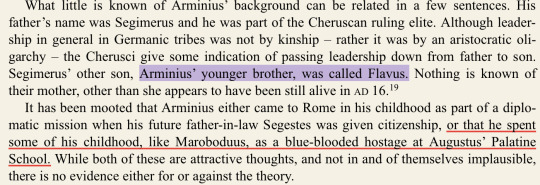

(ibid)
this post is already a mile long, so lets add another mile to it: a little scene at the start of their conversation! tfw you go in for a hug and your younger brother who also ended up being taller starts roasting your hair style
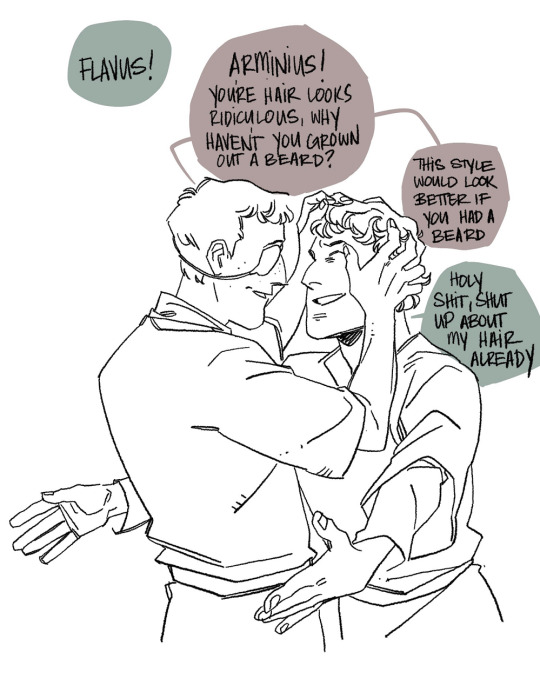
bsky ⭐ pixiv ⭐ pillowfort ⭐ cohost ⭐ cara.app⭐ko-fi
#long post#SO LONG#roman empire tag#tbh im not jazzed about using that tag when rome is not actually the setting here but i do not have a good era tag for this yet#i'll figure it out later eurhghghesuerhgh#komiks tag#arminius & flavus#idk. maybe also#eye trauma cw#anyway it's all very 'he's my brother and i need a shovel to love him' kind of deal#this (wheezing) this is an idea i had LAST YEAR but it was a solo illustration#i had it posted for about ten minutes before i decided it sucked ass and needed to be revisited as a comic#FINALLY. the idea is complete. im free. it's been bothering me to have it unfinished while the original idea was haunting my drafts#as a reminder to get it done. and now i can delete it. au revoir illustration you will not be missed
333 notes
·
View notes
Text

Roman cavalry mask recovered from the Teutoburg Forest in Germany, site of a battle in which the Germans ambushed and a annhilated three Roman legions in 9 AD
747 notes
·
View notes
Text
It’s so funny how everyone’s a culture war guy now, from Putin getting interviewed by Tucker Carlson today, to Taliban fighters being Andrew Tate reply guys on Twitter and complaining about feminism in movies.
Do you think this was always a thing or is this a new type of guy? Like when Putin went “the Russian people are like J K Rowling, because we are being unfairly cancelled by the woke left,” were we always doing this?
Do you think 2000 years ago the Cherusci were going “much like the saint of the Christians, unjustly put upon the cross, I too am being wrongly persecuted for my warrior prowess displayed during the Battle of the Teutoburg Forest”?
158 notes
·
View notes
Text
Since the announcement that two or three new versions of Ghosts are in the works, I've been thinking about what sort of ghosts we might get to see / I'd like to see in a German adaptation and put together a list of my ideas. You will see some similarities with our beloved original ghosts as well as completely new characters, and I did my best to find a balance between male and female characters and include a variety of historical eras.
This is obviously just a very basic list with some notes but I do have thoughts about these characters (how they died, what powers they might have, their inner conflict etc.) so if you'd like to know more, please ask (also German producers, I hereby officially volunteer as tribute writer)!
German Ghosts
Female Neanderthal (40,000 BC)
Neanderthals were named after the German Neander valley so I think it's only fair to include a Neanderthal in the show. Since no one needs a Robin 2.0, I'd make the character female and give her a dog because ghost animals are fun and we need more of them.
Roman & German (9 AD)
Two guys - let's call them Marcus and Alber - who fought on opposite sides died in the Battle of the Teutoburg Forest, became ghosts and eventually best friends. They'd rather die again than admit that to anyone, though.
Bog Girl (600 AD)
A little girl who haunts the marshlands around the house but not the property itself. Most of the ghosts avoid her until the Naturalist gets curious and starts to befriend her.
Plague Ghosts (Mid-1600s)
A group of victims of the 30 Years' War whose deaths were caused by famine and disease and not the war directly (though they insist they died 'in the war').
Naturalist (Late 1700s)
A scientist like Alexander von Humboldt and Charles Darwin who embraces becoming a ghost from the get go and does various experiments (on himself and the others) to figure out how ghost rules work and what is and isn't possible.
Composer (Early 1800s)
A young composer who has a (perceived) rivalry with Beethoven because he's lost part of his hearing. Think German equivalent of Thomas Thorne.
Female Soldier (Early 1800s)
Based on stories like that of Friederike Krüger, this woman posed as a man and joined the army during the Napoleonic Wars.
Woman in White (Late 1800s)
The lady of the house at the time. After she died in childbirth, she was forced to watch her husband's mistress raise her daughter. She died wearing her white nightgown (something she is quite embarrassed about) and can be seen in pictures.
WW1 Surgeon (1930s)
Another former owner of the house, this man was a surgeon in WW1 and still carries the trauma of that time with him (think Siegfried from All Creatures Great and Small).
Luftwaffe Pilot (1940s)
Remember the two German pilots from BBC Ghosts? This guy was their friend and has always wondered what happened to them. He crash-landed on the grounds during a training exercise.
Estate Agent (early 2020s)
A woman who took over the house after the last owner passed away. While assessing the property, she had a heart attack and died there, leading to rumours about the house being cursed and haunted increasing.
The House
While the house will probably be a manor house like in the original series, I think it would be fun if this version of the show shook things up a little and had the German Coopers inherit an old mill, or perhaps even an actual (small) castle.
#this has honestly been so much fun to think about#I don't know how many German fans there are in this fandom but I'd love to know what sort of characters you guys would want to see#bbc ghosts#mp bbc ghosts#german ghosts
67 notes
·
View notes
Text
New favorite thing about writing this arranged marriage AU: I can be as self-indulgent with historical detail as I want! 🤓🥹🥰
That's one of those things that it's easy to know intellectually but hard to internalize until the actual writing process. Hope y'all are ready to learn about the following representative sample of topics in excruciating detail:
Sauna construction
Food preservation (subtitle: I just think it's neat that borts is more nutritious than modern field rations)
The internal social politics of patrician families in Late Republican Rome*
Horse archery
Archeology at Pompeii*
Guerilla warfare and supply lines
Aqueducts
✨CLOAKS✨
The Battle of Teutoburg Forest*
For now I'm choosing to blame most of this on Stede's autistic coding (cough my own projection cough) but that's really just an excuse. An excuse I'm thrilled to hide behind for my own sanity in the decade it's gonna take me to finish this thing if I continue to keep getting so distracted by research/inventing mythology that will inform the worldbuilding but not make it into the fic with any actual detail.
And you can't stop me!!!!
*this is more inspiration than anything because it's not set in our world and therefore not in actual Rome but you you know what I mean
#baby's second longfic#ofmd au#arranged marriage au#fic writing#my fic writing#ofmd fic#WIPs#ofmd#our flag means death#edward teach#stede bonnet#gentlebeard#blackbonnet#also I just figured out how Izzy fits into everything#it's gonna be so good#unrelated to the fic itself#thinking about indigenous food preservation got me thinking about pemmican#which I had in an indigenous owned and run restaurant in Vancouver#with bannock and a root vegetable I forgot the name of#it was incredible#and now I have a craving I can't satisfy from the US and also thousands of miles away#I do have a local friend that could probably hook me up with some fry bread though#today's favorite thing
23 notes
·
View notes